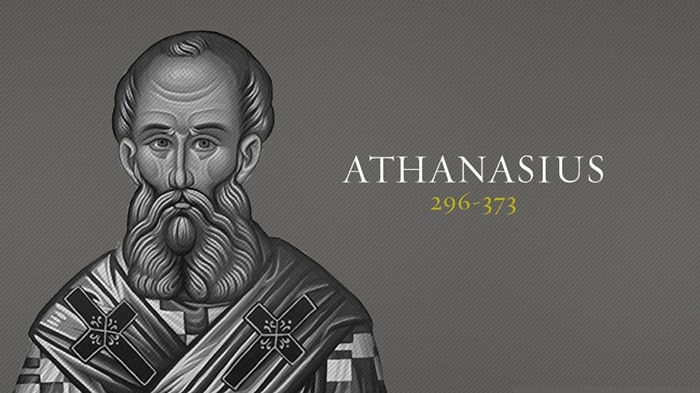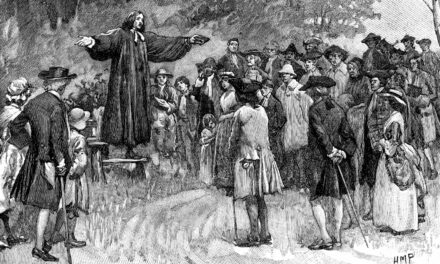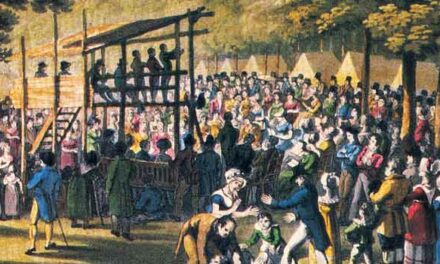This is part 4 of our series on the Creeds.
Because most of the creeds were the product of a Council of one kind or another, when dealing with the creeds, we have to talk about the Council.
The Creed we’re looking at in this episode, the Athanasian Creed, wasn’t the product of a Council. And, like the Apostle’s Creed we looked in the first episode, it almost certainly wasn’t composed by Athanasius, just as the Apostle’s Creed wasn’t written by the Apostles.
The origin of the Athanasian Creed remains a mystery. Athanasius, you’ll remember, was an elder at the church of Alexandria and accompanied his pastor, Bishop Alexander, to Nicaea for the council, where together, they were some of the chief voices arguing against another elders from Alexandria named Arius who’d gone off the rails on the deity of Christ. Following Alexander’s term as the Bishop of Alexandria, Athanasius took on that rol e, and in the years that followed, though Arianism ought to have been a moot point after being nailed into a theological coffin at Nicaea, it managed to go zombie and began once again chewing on the churches, many of which once again were infected. Athanasius stood against the tide of this resurgent Arianism; sometimes, seeming to be all alone. In fact, at times, the political winds blew against him and he was exiled for standing for Nicene Orthodoxy.
Think of Athanasius as a general leading an ever shrinking number of troops in a war of theology & doctrine. If we were to single him out for the one thing he clung to, it was the Nicene tenet that God the Father & God the Son share the same substance – in Greek, homoousios.
While Constantine deferred to the wisdom of theologians in settling the Arian challenge, following emperors weren’t as skilled. They were Arians and allowed the heresy to re-emerge. Since Arianism was the accepted doctrinal position of court, it became politically expedient for church leaders to tow the line. Athanasius refused to allow politics to corrupt either himself or his church. For this, he was exiled. At one trial, when told that everyone else had gone over to the other side, he replied, “Athanasius contra munduma” = Athanasius against the world. He spent 17 years in 5 exiles by 4 emperors.
And as much of a champ as Athanasius was, he almost certainly had nothing to do with writing the creed which bears his name.
Athanasius died in 373 and never mentions the creed even once in his writings. The next 3 creeds following his death never refer to it, as they most certainly would have in the formulation of their creeds. One the contrary, the Creed bears the marks of the work of those creeds. Our best evidence is that the Creed came from the churches of North Africa that had been influenced by Augustine.
In its earliest use, the Athanasian Creed wasn’t called a creed; it was called “The Faith of Athanasius.” And like the Apostles’ Creed, it derived its relevance not from its author but rather to the truth it expressed and HOW it expressed it.
Maybe first evidence of the creed was connected to Caesarius of Arles about 502. He transcribed the entire creed in a preface to a collection of sermons. He said he was attaching the creed, “because it is necessary . . . that all clergy, and laymen as well, should be familiar with the Faith” so they’d know what to teach. By 1090, the medieval theologian Anselm of Canterbury linked the Athanasian, Apostles’, and Nicene Creeds as the Tria Symbola, the Three Creeds of the Christian Faith.
The creed wielded major influence during the Reformation. It lies at the opening of the Lutheran Book of Concord along with the Apostles’ & Nicene Creeds. It’s used by several Reformed churches, and it was mentioned approvingly in the Augsburg Confession, the Formula of Concord, the 39 Articles, the 2nd Helvetic Confession, the Belgic Confession, and the Bohemian Confession. Luther said the Athanasian Creed was “the most important and glorious composition since the days of the apostles.” Calvin considered it one of “the three symbols” that stand forever alongside God’s Word. Church historian Philip Schaff wrote of the Athanasian Creed, “This Creed is unsurpassed as a masterpiece of logical clearness, rigor, and precision.”
High praise! But the Creed was rejected by the Greek Church because of it’s position on the Holy Spirit.
The Creed consists of 42 articles, divided into 3 parts. The 1st addresses the Trinity, relying heavily on Augustine’s ideas, going so far as to quote him verbatim; making it pretty clear that it wasn’t written by Athanasius, since he died when Augustine was still young & a pagan.
The 2nd section defends the dual natures of Jesus the Council of Chalcedon explained in 451. We’ll get in to a lot more detail on all that when we take a look at the Councils of the 4th & 5th Cs. The 3rd section of the creed is a list of condemnations for those who refuse to the assertions of the creed. This part of the creed has proven to be difficult for those who don’t want their opponents consigned to a verbal damnation. But the fact is, most of the early creeds & confessions had a list of “anathemas,” that is, beliefs considered unacceptable in light of the beliefs that had just been articulated as embodying the Christian Faith. If “A” is exclusively true, “anti-A” can’t be.
Okay, enough jawing ABOUT the Creed. Let’s read it . . . à BUT . . .
Before we do, I need to clarify a word = Catholic. We find it a LOT in the writings of the early church. It does NOT mean a denomination or branch of the church with headquarters in Rome. The word catholic meant universal. When the Church father wrote or spoke of the catholic faith, they meant the faith all genuine Christians believed.
Okay, here we go …
Whosoever will be saved, before all things it is necessary that he hold the catholic faith. Which faith except every one do keep whole and undefiled; without doubt he shall perish everlastingly. And the catholic faith is this: That we worship one God in Trinity, and Trinity in Unity; Neither confounding the Persons; nor dividing the Essence.
For there is one Person of the Father; another of the Son; and another of the Holy Ghost. But the Godhead of the Father, of the Son, and of the Holy Ghost, is all one; the Glory equal, the Majesty coeternal. Such as the Father is; such is the Son; and such is the Holy Ghost. The Father uncreated; the Son uncreated; and the Holy Ghost uncreated. The Father unlimited; the Son unlimited; and the Holy Ghost unlimited. The Father eternal; the Son eternal; and the Holy Ghost eternal. And yet they are not three eternals; but one eternal.
As also there are not three uncreated; nor three infinites, but one uncreated; and one infinite. So likewise the Father is Almighty; the Son Almighty; and the Holy Ghost Almighty. And yet they are not three Almighties; but one Almighty. So the Father is God; the Son is God; and the Holy Ghost is God. And yet they are not three Gods; but one God. So likewise the Father is Lord; the Son Lord; and the Holy Ghost Lord. And yet not three Lords; but one Lord.
For like as we are compelled by the Christian verity; to acknowledge every Person by himself to be God and Lord; So are we forbidden by the catholic religion; to say, There are three Gods, or three Lords. The Father is made of none; neither created, nor begotten. The Son is of the Father alone; not made, nor created; but begotten. The Holy Ghost is of the Father and of the Son; neither made, nor created, nor begotten; but proceeding. So there is one Father, not three Fathers; one Son, not three Sons; one Holy Ghost, not three Holy Ghosts.
And in this Trinity none is before, or after another; none is greater, or less than another. But the whole three Persons are coeternal, and coequal. So that in all things, as aforesaid; the Unity in Trinity, and the Trinity in Unity, is to be worshipped. He therefore that will be saved, let him thus think of the Trinity.
Furthermore it is necessary to everlasting salvation; that he also believe faithfully the Incarnation of our Lord Jesus Christ. For the right Faith is, that we believe and confess; that our Lord Jesus Christ, the Son of God, is God and Man; God, of the Essence of the Father; begotten before the worlds; and Man, of the Essence of his Mother, born in the world. Perfect God; and perfect Man, of a reasonable soul and human flesh subsisting. Equal to the Father, as touching his Godhead; and inferior to the Father as touching his Manhood. Who although he is God and Man; yet he is not two, but one Christ. One; not by conversion of the Godhead into flesh; but by assumption of the Manhood by God. One altogether; not by confusion of Essence; but by unity of Person. For as the reasonable soul and flesh is one man; so God and Man is one Christ.
Who suffered for our salvation; descended into hell; rose again the third day from the dead. He ascended into heaven, he sits on the right hand of God the Father Almighty, from whence he will come to judge the living and the dead. At whose coming all men will rise again with their bodies; And shall give account for their own works. And they that have done good shall go into life everlasting; and they that have done evil, into everlasting fire. This is the catholic faith; which except a man believe truly and firmly, he cannot be saved.
Surely you noted how very careful this creed handles the issues, 1st of the Trinity, & 2nd, of the 2 natures of Christ. A word on that . . .
Theologians have long discussed how almost any attempt to [air-quote] “explain” God, and specifically, the Trinity, is destined to end up saying something that’s not quite right. And that not quite rightness becomes a toehold for misunderstanding and the geneis of error that can break out in heresy. Either God is made out to be three gods, or the 3 divine persons of Father, Son, and Spirit are turned into a messy amorphous mish-mash that does nothing but confuse. The reason for this is because to speak about God as a Trinity as the Bible presents Him, requires a vocabulary & philosophical background different from speaking about literally – any other thing. God is categorically separate from all other subjects. God is God, & nothing else is. When we are dealing with the Trinity, we’re entering into what theologians call the “aseity” of God; God as He is in & to himself. Since God is perfect & infinite, He will ALWAYS transcend His creation, of which we are. So while we struggle to grasp how the Trinity “works,” don’t get frustrated if you find your understanding falling short. Rather, take comfort in that. For a God you could completely understand would be a god too small to worship. The essence of worship is awe. WE need to have the sense that we stand in the presence of something infinitely bigger & beyond, or worship has no fuel.
Because of God’s gracious self-revelation, we can apprehend Him. But because of his infinity, we cannot comprehend Him.
Given this challenge in culling what Scripture tells us about the Trinity into a succinct Statement of Faith, the Athanasian Creed is about as careful and thorough an attempt as is found in history. It describes the core doctrine of the Trinity, then sets boundaries to prevent misunderstandings.
The Athanasian Creed guides through key qualities & attributes shared by all three persons of the Trinity. God is uncreated, unlimited, & eternal.
The wording of the Creed may at times seem a bit thick and heavy-handed in its repetition of God being 1 in Essence but 3 in Person. Whenever you see something like that, understand it as a clue to the historical setting that birthed it. A Neo-Arianism had risen that pretended to be faithful to Nicene orthodoxy, but was in fact a return to the idea that while Jesus & the Holy Spirit are God, they are less God than the Father, who alone sits at the top of the divine triangle. This was the position of royalty, because it allowed them some wiggle room to attach themselves to a position at the top of society with everyone else below them.
Some have wondered why, for goodness sake, the early Christians didn’t just chuck all this arguing about the Trinity and go for simply monotheism. The answer to that is simple= Because early Christians didn’t have a choice. Scripture was God’s Word, His self-revelation. So if it said there was one God, but 3 persons all claimed to be that one God, then that meant God is One in Essence but three in person.
Well, why not go along with the ideas of Sabellius in the early 3rd C who said there’s one God, who’s chosen 3 different modes to reveal Himself in; as Father with Israel, as the Son Jesus during the Incarnation, and as the Spirit after Jesus’ ascension. This idea was called Sabellianism, or modalism and persists to this day in some groups.
Again, Modalism simply doesn’t square with Scripture. Only one view does, classic orthodox Trinitarianism accommodates ALL of Scripture. And yes, that makes things difficult for us because it’s hard to reconcile intellectually. But the more one meditates on the Trinity, the more blessing and goodness flows from it. We see that built into the very nature and character of God is the reality of relationship & mutuality, fellowship, sharing.
The Creed ends with a bold but terse comment that those who believe its tenets are saved, but those who reject them are eternally damned. And as you may well imagine, that’s raised a hew & cry for many years. There are those who have no problem with other stating their beliefs in bold, clear terms. But to then say salvation lies in agreeing with them while failure to do so results in condemnation, well, wait just a minute there pal! Back the carriage up! Who are you to tell me what I HAVE to believe?
Consider this: Bill tells Ted he has to eat or he’ll starve. What would we think of Ted if he told Bill that was very narrow thinking & that Ted’s deeply offended by Bill’s certainty. Ted’s not hungry and is disturbed by the thought a failure to eat will result in his death.
In a situation like this, we judge Ted as unreasonable. Because we know the connection between food and health.
People who take offense at the Creeds for saying “Believe this and live, don’t a die” are like Ted. They assume that heaven and hell aren’t settled destinations all people end up in. They assume there’s some other way than the one the Creed is so careful to plot.
The authors of the creeds weren’t aggressively drawing a fence around the Faith to keep people out. They were posting big, bold signs pointing to the only way in.





